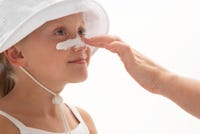March 29, 2011

 You can always count on longer days, warmer temperatures and spring-break vacations to pull sun care sales out of a winter slump. Especially since heightened awareness of skin-cancer risk pushes more people to purchase and use sunscreen every year. But I predict that this year, perhaps more than ever, mineral-based sun-protection products will fly off store shelves.
You can always count on longer days, warmer temperatures and spring-break vacations to pull sun care sales out of a winter slump. Especially since heightened awareness of skin-cancer risk pushes more people to purchase and use sunscreen every year. But I predict that this year, perhaps more than ever, mineral-based sun-protection products will fly off store shelves.
Why will this year yield mega sales of natural sun care? A few reasons. First off, the Food and Drug Administration had planned to release its long-talked-about updated sunscreen monograph last October. The new labeling regulations would include implementing a four-star UVA-protection rating key (SPF indicates protection only from sunburn-causing UVB rays; UVAs cause cancer), outlawing the term waterproof and capping the allowable SPF claim at 50.
True, six months have now passed and still no new monograph has been published. The delay, as FDA Spokeswoman Shelly Burgess told me last fall, is due to the massive amount of public-response submissions the agency has received since proposing the updates in 2007—all of which must be reviewed.
Even so, the impending regulations garnered much media attention over the past few years, alerting many non-naturals consumers to the shortcomings of current sunscreen labels and sending them looking for better protection—which often means UVA-blocking zinc oxide and titanium dioxide formulations. In addition, the Environmental Working Group’s annual Sunscreen Guide, which rates the best and worst sunscreens based on UVA and UVB protection and safe, natural ingredients, gained major traction both in 2009 and 2010, calling even more attention to mineral formulations’ benefits.
What’s more, besides not effectively warding off dangerous UVA rays, conventional sunscreen chemicals have increasingly come under fire for their potential health ramifications. In 2008, a Centers for Disease Control and Prevention study detected oxybenzone (aka benzophenone-3)—linked to allergies, cell damage and even hormone disruption—in the blood of 97 percent of people tested. That same year, Mount Sinai School of Medicine research linked oxybenzone to low birth weight of girls born to mothers exposed to the chemical while pregnant. Public health watchdog groups like the EWG have been trumpeting these results and cautioning against chemical sunscreens for years, but mainstream media really began moving the message last year.
Also in mineral sun care’s corner? More products. This year’s Natural Products Expo West was awash with newly launched sun care lines from established major manufacturers and upstart companies alike, so be sure to check out what your best-selling brands are rolling out and which new manufacturers may be worth a look. Also—and this is huge—better products. The primary complaints about mineral blocks have long been the chalky film and cakey feel, but companies like Badger, Aubrey Organics and Goddess Garden have really stepped up the game, making spreadable, non-ghostly products, even without using the easier-to-distribute-yet-possibly-health-harming nanoparticles. I rubbed several ’screens onto my arms while visiting various companies’ booths and saw nary a white streak, even under the Anaheim Convention Center’s exposing fluorescent lights.
It’s an exciting time in the natural sun care arena, so stock up to get customers slathering.
About the Author(s)
You May Also Like




